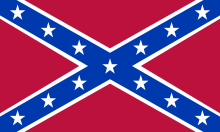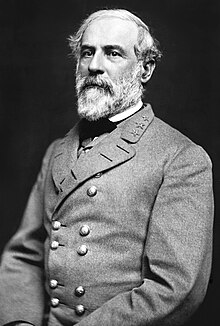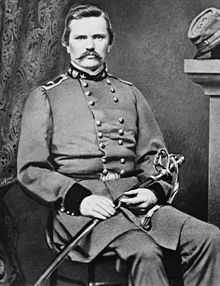|
Military forces of the Confederate States
   The military forces of the Confederate States, also known as Confederate forces or the Confederate Armed Forces and Confederate States Armed Forces, were the military services responsible for the defense of the Confederacy during its existence (1861–1865). OrganizationThe military forces of the Confederate States had three services:
Command and control
Control and operation of the Confederate States Army was administered by the Confederate States War Department, which was established by the Confederate Provisional Congress in an act on February 21, 1861. The Confederate Congress gave control over military operations, and authority for mustering state forces and volunteers to the president of the Confederate States of America on February 28, 1861 and March 6, 1861. By May 8, a provision authorizing enlistments for war was enacted, calling for 400,000 volunteers to serve for one or three years. By April 1862, the Confederate States of America found it necessary to pass a conscription act, which drafted men into PACS. The Confederate military leadership included many veterans from the United States Army and United States Navy who had resigned their federal commissions and had won appointment to senior positions in the Confederate armed forces. Many had served in the Mexican–American War (including Robert E. Lee and Jefferson Davis), but others had little or no military experience (such as Leonidas Polk, who had attended West Point.) The Confederate officer corps was composed in part of young men from slave-owning families, but many came from non-owners. The Confederacy appointed junior and field grade officers by election from the enlisted ranks. Although no Army service academy was established for the Confederacy, many colleges of the South (such as the Citadel and the Virginia Military Institute) maintained cadet corps that were seen as a training ground for Confederate military leadership. A naval academy was established at Drewry's Bluff, Virginia,[3] in 1863, but no midshipmen had graduated by the time the Confederacy collapsed. The soldiers of the Confederate armed forces consisted mainly of white males with an average age between sixteen and twenty-eight.[citation needed] The Confederacy adopted conscription in 1862. Many thousands of slaves served as laborers, cooks, and pioneers. Some freed blacks and men of color served in local state militia units of the Confederacy, primarily in Louisiana and South Carolina, but their officers deployed them for "local defense, not combat."[4] Depleted by casualties and desertions, the military suffered chronic manpower shortages. In the spring of 1865 the Confederate Congress, influenced by the public support by General Lee, approved the recruitment of black infantry units. Contrary to Lee's and Davis' recommendations, the Congress refused "to guarantee the freedom of black volunteers." No more than two hundred troops were ever raised.[5] However, President Davis believed that blacks would not fight unless they were provided freedom in exchange for their service. Therefore, he waited until Congress adjourned and then stipulated by executive order that any African-American accepted into service on the congressional act must be a volunteer and be accompanied by manumission papers.[6] Military leadersMilitary leaders of the Confederacy (with their state or country of birth and highest rank[7]) included:  
African Americans in the Confederate militaryA small number of free persons of color in New Orleans formed the 1st Louisiana Native Guard (CSA) as part of the Louisiana militia. The unit temporarily disbanded on February 15, 1862, after Louisiana law stated the militia could only be made up of white men. They were recalled to service during the Union invasion of New Orleans and permanently disbanded on April 25, 1862. Some of the soldiers later joined the Union Army. "Nearly 40% of the Confederacy's population were unfree ... the work required to sustain the same society during war naturally fell disproportionately on black shoulders as well. By drawing so many white men into the army, indeed, the war multiplied the importance of the black work force."[8] Even Georgia's governor Joseph E. Brown noted that "the country and the army are mainly dependent upon slave labor for support."[9] Slave labor was used in a wide variety of support roles, from infrastructure and mining, to teamster and medical roles such as hospital attendants and nurses.[10] The idea of arming slaves for use as soldiers was speculated on from the onset of the war, but not seriously considered by Davis or others in his administration.[11] Though an acrimonious and controversial debate was raised by a letter from Patrick Cleburne[12] urging the Confederacy to raise black soldiers by offering emancipation, it would not be until Robert E. Lee wrote the Confederate Congress urging them that the idea would take serious traction. On March 13, 1865, the Confederate Congress passed General Order 14, and President Davis signed the order into law. The order was issued March 23, but only a few black companies were raised. Two companies were armed and drilled in the streets of Richmond, Virginia, shortly before the besieged southern capital fell. However, President Davis considered it imperative that blacks be offered freedom in exchange for military service under terms of the act passed through Congress. Therefore, he waited for Congress to adjourn and then stipulated by executive order that any African-Americans accepted as soldiers under terms of the act must be volunteers and be accompanied by manumission papers.[13] SupplyMuch like the Continental Army in the American Revolution, state governments were supposed to supply their soldiers. The supply situation for most Confederate Armies was dismal even when victorious. The lack of central authority and effective transportation infrastructure, especially the railroads, combined the frequent unwillingness or inability of Southern state governments to provide adequate funding, were key factors in the Army's demise. Individual commanders had to "beg, borrow or steal" food and ammunition from whatever sources were available, including captured Union depots and encampments, and private citizens regardless of their loyalties. Lee's campaign against Gettysburg and southern Pennsylvania (a rich agricultural region) was driven in part by his desperate need of supplies, namely food. Not surprisingly, in addition to slowing the Confederate advance such foraging aroused anger in the North and led many Northerners to support General Sherman's total warfare tactics as retaliation. Scorched earth policies especially in Georgia, South Carolina and the Virginian Shenandoah Valley proved far more devastating than anything Pennsylvania had suffered and further reduced the capacity of the increasingly effectively blockaded Confederacy to feed even its civilian population, let alone its Army. At many points during the war, and especially near the end, Confederate Armies were described as starving and, indeed, many died from lack of food and related illnesses. Towards more desperate stages of the war, the lack of food became a principal driving force for desertion. UniformsSee article: Uniforms of the Confederate Military The Uniforms of the Confederate States military forces were the uniforms used by the Confederate Army and Navy during the American Civil War from 1861 to 1865. The uniform varied greatly due to a variety of reasons, such as location, limitations on the supply of cloth and other materials, and the cost of materials during the war. Confederate forces were often poorly supplied with uniforms, especially late in the conflict. Servicemen sometimes wore combinations of uniform pieces combined with captured Union uniforms and items of personal clothing. They sometimes went without shoes altogether, and broad felt or straw hats were worn as often as kepis or naval caps. StatisticsTotal Service members – 1,050,000 (Exact number is unknown. Posted figure is average of estimated range from 600,000 – 1,500,000) Battle Deaths (Death figures are based on incomplete returns) – 74,524 Other Deaths (In Theater) – 59,297 Died in Union prisons – 26,000 to 31,000 Non-mortal Woundings – Unknown At the end of the war 174,223 men surrendered to the Union Army.[14] See also
References
External linksWikimedia Commons has media related to Confederate States of America.
|
||||||||||||||||||||||||||||||||||


